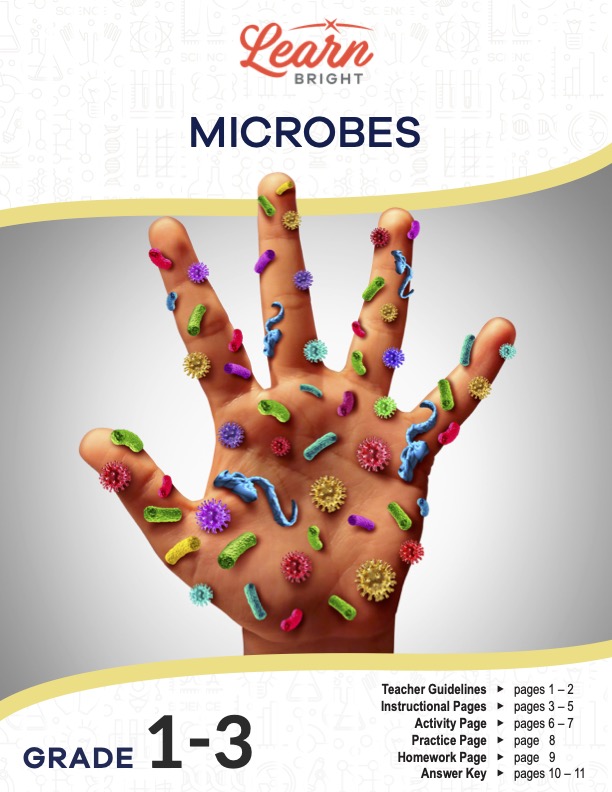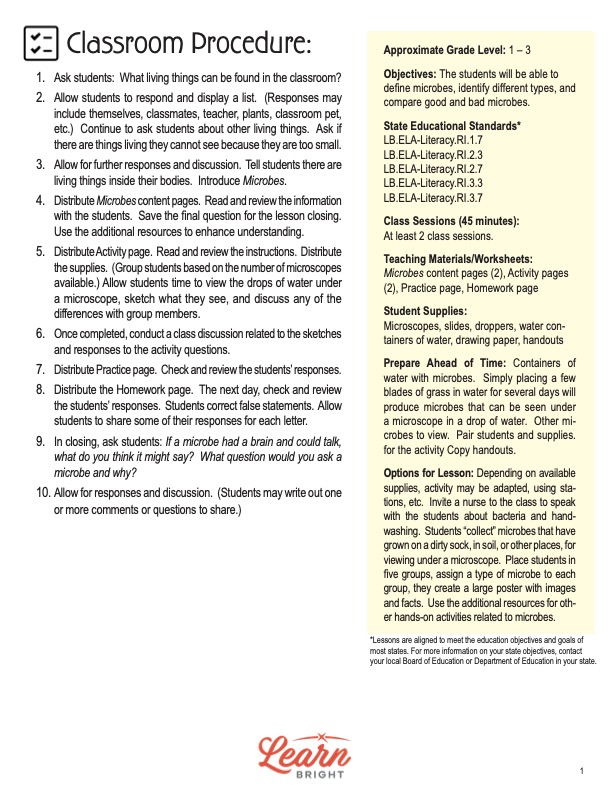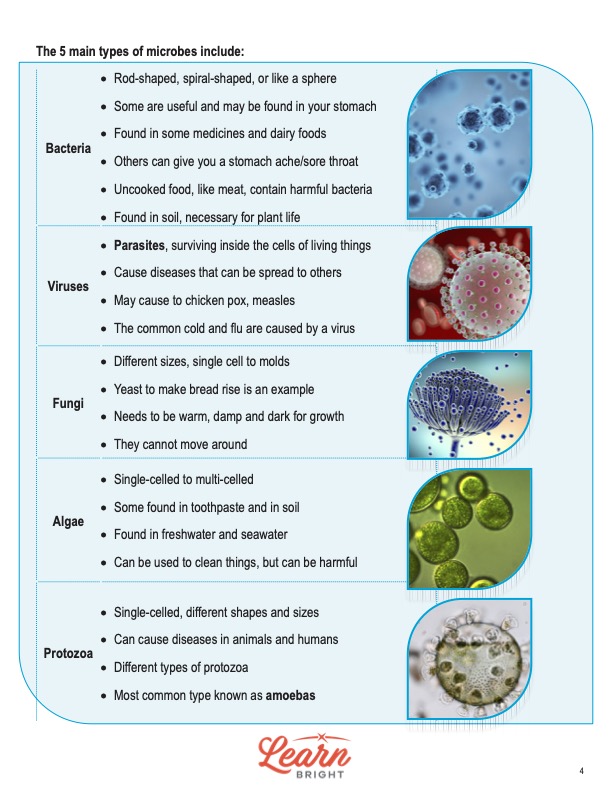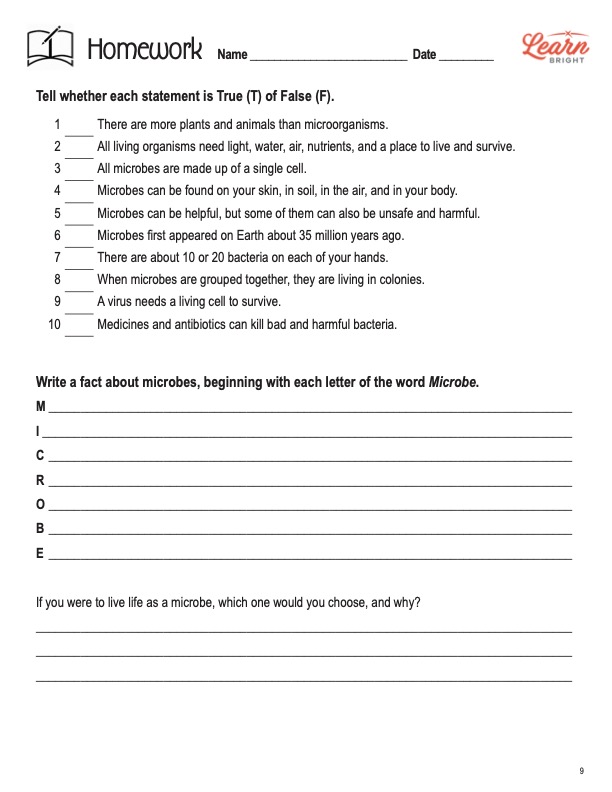Description
What our Microbes lesson plan includes
Lesson Objectives and Overview: Microbes introduces students to germs and teaches them about the different types. Students will be able to identify these microbes and compare and contrast the good ones and the bad ones. They will also learn that microorganism is another term to describe these tiny living things. This lesson is for students in 1st grade, 2nd grade, and 3rd grade.
Classroom Procedure
Every lesson plan provides you with a classroom procedure page that outlines a step-by-step guide to follow. You do not have to follow the guide exactly. The guide helps you organize the lesson and details when to hand out worksheets. It also lists information in the yellow box that you might find useful. You will find the lesson objectives, state standards, and number of class sessions the lesson should take to complete in this area. In addition, it describes the supplies you will need as well as what and how you need to prepare beforehand. This lesson requires microscopes, slides, droppers, containers of water, and drawing paper.
Options for Lesson
In the “Options for Lesson” section of the classroom procedure page, you will see some suggestions for additional activities or ideas to add to the lesson if you want to. One idea, depending on available supplies, is to adapt the activity in creative ways, such as setting up stations. Another option is to invite a nurse to the class to speak with the students about bacteria and hand-washing. Students could “collect” microbes that have grown on a dirty sock, in soil, or other places for viewing under a microscope. As an extra activity, you could divide students into five groups and assign each one a type of microbe. Every group will work together to create a large poster with images and facts about their assigned microbe.
Teacher Notes
The teacher notes page provides an extra paragraph of information to help guide the lesson. It explains that it isn’t necessary for students to memorize all the terms, but they should be aware that there are different types of microbes. You can use the space on the page to write down any other ideas or thoughts you have about the topic as you prepare.
MICROBES LESSON PLAN CONTENT PAGES
Microorganisms and Microbes
The Microbes lesson plan has three pages of content. There are many living things throughout the Earth, which we call organisms. They come in all different sizes. Most of the organisms we see are animals and plants. Animals include humans, dogs, cats, fish, rabbits, bugs, and many others. Plants include things like trees, vegetables, fruits, flowers, and much more.
However, there are extremely tiny organisms called microbes or microorganisms. Most are not visible at all without using a microscope. Microbes exist literally everywhere in the world. And just like bigger organisms, such as plants and animals, many microbes need the same things to survive.
Nearly all living organisms need light, water, air (oxygen), nutrients (food), and a place to live that has the right temperature. All living organisms also live, grow, and reproduce. The number of microbes in the world outnumber all other living things combined. In fact, there are many, many more microbes inside the human body than there are people on Earth. Most microbes are made up of a single cell.
Students will learn that they can find these microorganisms in the soil, in the air, on their skin, and inside their body. Most of the microbes in the world are not harmful to humans but can instead be very helpful. However, there are some that are harmful, too. Nevertheless, humans and other animals (and plants) cannot survive without microbes.
Five Types of Microbes
There are trillions and trillions of microbes everywhere on Earth. We usually sort them into five different types: bacteria, viruses, fungi, algae, and protozoa. Just as there are types of animals such as mammals and fish, there are different types of microbes. Some of them can be found alone while others work in colonies or group together. Scientists believe microbes appeared on Earth about 3.5 billion years ago and helped with life on the planet.
The lesson explains some information about each of the five types of microorganisms. Bacteria, for instance, come in the shapes of rods, spirals, or spheres. Some are useful and exist in the stomach, in medicines, and in some dairy foods. Others are harmful and can make us feel sick.
Algae is another type. It exists in both freshwater and saltwater sources. While we can use to clean things, it can also be harmful. Protozoa come in different shapes and sizes as well. These microbes can cause diseases in animals, including humans. The most common type is known as an amoeba.
Most microbes are safe and helpful. The ones that cause the most problems, like a cold or flu virus, are usually well known. Microbes also produce about half of the oxygen that exists on Earth. They often have a bad reputation, and many people mistakenly think all of them are bad. But without microbes, other living organisms could not survive, including people.
Other Facts
Students will learn that most microbes can live anywhere—extreme heat, cold, in darkness, under pressure. They can also exist in places where no other life can. We bring them to school and take them home. Right now, there are between 10,000 and 10 million bacteria on each of our hands. That number depends on how clean or dirty they are. After we use the bathroom, the number of germs on our fingertips doubles. And when we cough, the germs can travel about three feet.
Bacteria and other microbes can be spread easily, from our hands to other places, when we cough, and so on. Therefore, it is important to keep our hands clean and to cover our mouth (not with our hands!) when we cough. If bacteria cause us to become sick, there are medicines called antibiotics that can kill the bad bacteria.
In summary, there are five main types of microbes, but there are trillions and trillions of them everywhere on Earth. There are some good microbes and some bad microbes. Inside the body, there are good microbes. But if a bad microbe enters our body, we can get sick. Regardless of what people think, microbes are necessary for all living organisms to survive.
MICROBES LESSON PLAN WORKSHEETS
The Microbes lesson plan includes three worksheets: an activity worksheet, a practice worksheet, and a homework assignment. These worksheets will help students demonstrate what they learned throughout the lesson and reinforce the lesson concepts. The guide on the classroom procedure page outlines when to hand out each worksheet to your students.
UNDER A MICROSCOPE ACTIVITY WORKSHEET
Students will work with a partner or in small groups for the activity. Using the supplies you provide, they will put together slides to view under a microscope. First, they will place a drop of water on one slide and take turns looking at it through the microscope. They will then sketch a picture of what they see in the first box on the worksheet.
After cleaning the slide and placing a new drop of water, they will again take turns looking at the slide and sketching what they see. If you want, you can have students sketch two more pictures of slides. The second worksheet page lists questions for students to respond to regarding what they observed.
MICROBES PRACTICE WORKSHEET
The practice worksheet is divided into two sections. The first section requires students to match facts to the correct type of microbe. There are 12 descriptions total to match. For the second part, students will review five images and identify which type of microbe (virus, fungus, bacteria, protozoa, and algae) each picture represents.
FACT TIME HOMEWORK ASSIGNMENT
Similar to the practice worksheet, there are two parts of the homework assignment. For the first part, students will mark 10 statements as either (T) or false (F). For the next part, they will write a fact about microbes beginning with each letter of the word. At the bottom of the page is one more prompt that asks them to explain which microbe they would choose to be if they were to live life as a microbe.
Worksheet Answer Keys
There are answer keys for the practice and homework worksheets at the end of the lesson plan. The correct answers are in red to make it easier to compare them with your students’ work. If you choose to administer the lesson pages to your students via PDF, you will need to save a new file that omits these pages. Otherwise, you can simply print out the applicable pages and keep these as reference for yourself when grading assignments.










